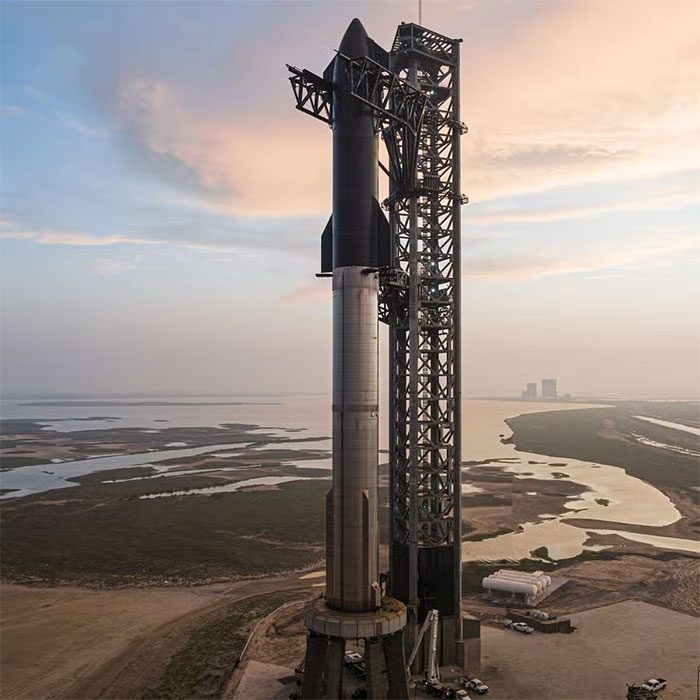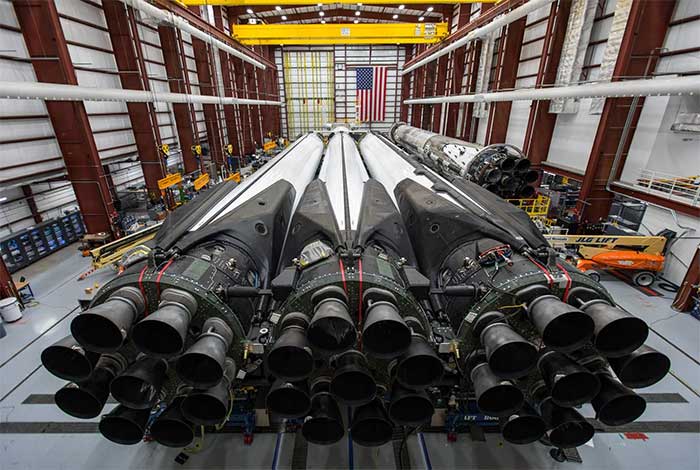In the race of the 21st century, who will cross the finish line first?
The U.S. Worries About Its Leading Position
“SpaceX has signed a contract with NASA to provide the Starship rocket-spacecraft system to send American astronauts to the Moon before China, but delays in obtaining launch approval for the Starship could jeopardize that plan,” warned Bill Gerstenmaier, Vice President of Flight Reliability and Construction at SpaceX, during a recent hearing on Capitol Hill.
Currently, the 121-meter tall, 5,000-ton Starship heavy launch system remains “stationary” on the launch pad in Boca Chica, Texas, fully ready for its second test launch attempt since early September 2023.
Notably, SpaceX is still awaiting launch approval from the Federal Aviation Administration (FAA), according to Space.com.

The Starship system (comprising the Starship spacecraft stacked on the Super Heavy rocket) is fully ready on the launch pad in Boca Chica, Texas, USA. (Photo: SpaceX/PA)
In light of this development, SCMP published an article titled “U.S. Rocket Unable to Launch, China Makes Leap in the Race to the Moon”, discussing the possibility that China could land on the Moon before the U.S. in the 21st century, echoing Bill Gerstenmaier’s concerns when he stated: “We will lose our dominant position in space and will witness China land on the Moon before the U.S.“
“There is no doubt. China will land on the Moon before 2023,” said Wu Weiren, Chief Designer of China’s Lunar Exploration Program, in a social media post.
How Do NASA and Space Analysts View This?
According to space observers, even as Starship faces legal and technical hurdles that have NASA officials publicly worried about its readiness for 2025, the U.S. is still significantly ahead of China in preparing for a crewed lunar landing.
China’s lunar landing mission has an architecture similar to the Artemis III program, which was recently approved by the Chinese government in early 2023 and aims for a launch date before 2030.
But how well has China prepared its “hardware” ahead of the Moon landing?
NASA has reported that China is actively developing heavy-lift rockets to support this ambition, including the Long March 9 and Long March 10 rockets.
Key Steps Toward the Moon
In an article published in April 2023, NASA stated that China has been quick to “copy technology” to develop the Chang Zheng 9 (CZ-9; also known as Long March 9) heavy-lift vehicle.
Initially, the Long March 9 was designed similarly to NASA’s Space Launch System (SLS), the backbone of the Artemis program, but over the years, it has been developed for partial reusability.
Recently, as SpaceX’s Starship system became more practical, China modified its design to make the Long March 9 a fully reusable launch system.

China hopes to land an astronaut on the Moon’s surface before 2030. (Source: Nasaspaceflight).
In 2021, coinciding with the time SpaceX was selected by NASA to develop the lunar lander version of Starship as part of the planned Artemis III mission scheduled for late 2025, China intensified its focus on developing the Long March 9.
In June 2021, the concept of a rocket that does not use side boosters was first mentioned. The first stage of the rocket is powered by 16 YF-135 RP-1 engines, producing approximately 360 tons of thrust per engine. Although reusability was not mentioned in this design, it appeared in subsequent developments.
In April 2022, during a presentation at the Beijing Institute of Technology (China), Chinese scientists mentioned that the Long March 9 could be at least partially reusable.
Around this time, China was focusing on upgrading the Long March 5 to the Long March 10, making it a key stepping stone to the Moon for China’s space program.
The Long March 10 is a three-core version of the Long March 5, with each core measuring 5 meters in diameter and increasing the number of engines under each core to 7 YF-100K engines. This enables the Long March 10 to deliver a payload of up to 70 tons to low Earth orbit (LEO) and up to 27 tons to the Moon.
According to Chinese officials, the fifth and sixth launches of the Long March 10 will involve the first crewed landing of Chinese astronauts on the Moon. One flight will carry the lander, while the other will carry the launch module and return module.

SpaceX’s Falcon Heavy rocket with 27 powerful engines can lift nearly 64 tons to LEO. (Photo: SpaceX).
NASA noted that the Long March 10 has followed the design of SpaceX’s Falcon Heavy and appears to be the “final step” in the design for the Long March 9.
The Falcon Heavy, one of the world’s most powerful operational rockets, consists of three cores with a total of 27 reusable engines, producing thrust equivalent to about 18 Boeing 747s taking off simultaneously. The Falcon Heavy can lift nearly 64 tons to LEO, according to SpaceX.com.
In the latest update received by the public on April 21, 2023, a day after SpaceX’s Starship system made its debut, the multi-stage design of the Long March 9 rocket was also reinforced.
The first stage of the Long March 9 will feature 30 engines in a 3-9-18 configuration, with three engines as the central engine and 18 engines in the outer ring.
The third stage of the rocket, using the YF-79 engine, provides additional velocity to propel the spacecraft into the designated orbit. This design is very similar to Starship.
China is expected to launch the Long March 9 in 2033. Meanwhile, the super-heavy Long March 10 is scheduled to debut in 2027.
NASA commented that there are many copying designs happening here, and China is not even trying to hide it. But ultimately, this could open up opportunities for them to catch up with the U.S., achieving the goals they desire as they have announced.





















































